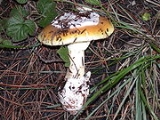
Amanita lanei
Encyclopedia
Amanita lanei also known as coccora or coccoli, is a white-spored mushroom
that fruits naturally in the coastal forests of the western United States
during the fall and winter. A spring form occurs which has a light yellow cap.
at the base of the stalk.
The spores of this species do not change color when placed in a solution of Melzer's reagent
, and thus are termed inamyloid. This characteristic in combination with the absence of a bulb at the base of the stalk place this mushroom in the Section Vaginatae.
, A. ocreata
and A. virosa
. The spring form of A. lanei is nearly the same color as the A. phalloides
and the edible species can be differentiated by its striate cap margin, lack of a true bulb at the base of the stem, volva attachment and inamyloid spores.
Mushroom
A mushroom is the fleshy, spore-bearing fruiting body of a fungus, typically produced above ground on soil or on its food source. The standard for the name "mushroom" is the cultivated white button mushroom, Agaricus bisporus; hence the word "mushroom" is most often applied to those fungi that...
that fruits naturally in the coastal forests of the western United States
United States
The United States of America is a federal constitutional republic comprising fifty states and a federal district...
during the fall and winter. A spring form occurs which has a light yellow cap.
Description
This mushroom is recognized by its large, orange-brown cap partially covered by a thick patch of universal veil, its white gills and spores, its cream-colored stalk adorned with a partial veil, a partially hollow stem (filled with a stringy white pith), and by the presence of a large, sacklike volvaVolva (mycology)
The volva is a mycological term to describe a cup-like structure at the base of a mushroom that is a remnant of the universal veil. This macrofeature is important in wild mushroom identification due to it being an easily observed, taxonomically significant feature which frequently signifies a...
at the base of the stalk.
The spores of this species do not change color when placed in a solution of Melzer's reagent
Melzer's Reagent
Melzer's reagent is a chemical reagent used by mycologists to assist with the identification of fungi.-Composition:...
, and thus are termed inamyloid. This characteristic in combination with the absence of a bulb at the base of the stalk place this mushroom in the Section Vaginatae.
Classification
Rodham E. Tulloss suggests that there may in fact be several distinct species currently grouped under the name Amanita lanei. For a brief discussion of the confused history behind the species name of this mushroom, read Nathan Wilson's article on A. laneiDistribution and habitat
This mushroom forms mycorrhizae with Madrone (Arbutus menziesii) in the southern part of its range (Central California northwards to Washington). However, in the northern part of its range (Washington to southern Canada), its preferred host is Douglas Fir (Pseudotsuga menziesii).Edibility
Experienced mushroom hunters regard this mushroom as a good edible species, but caution must be exercised when collecting A. lanei for the table, since it can be confused with other species in the genus Amanita. This genus contains some of the deadliest mushrooms in the world, most notably A. phalloidesDeath cap
Amanita phalloides , commonly known as the death cap, is a deadly poisonous basidiomycete fungus, one of many in the genus Amanita. Widely distributed across Europe, A. phalloides forms ectomycorrhizas with various broadleaved trees. In some cases, death cap has been introduced to new regions with...
, A. ocreata
Amanita ocreata
Amanita ocreata, commonly known as the death angel, destroying angel, angel of death or more precisely Western North American destroying angel, is a deadly poisonous basidiomycete fungus, one of many in the genus Amanita. Occurring in the Pacific Northwest and California floristic provinces of...
and A. virosa
Destroying angel
The name destroying angel applies to several similar, closely related species of deadly all-white mushrooms in the genus Amanita. They are Amanita bisporigera and A. ocreata in eastern and western North America, and A. virosa in Europe. Another very similar species, A. verna or fool's mushroom was...
. The spring form of A. lanei is nearly the same color as the A. phalloides
Death cap
Amanita phalloides , commonly known as the death cap, is a deadly poisonous basidiomycete fungus, one of many in the genus Amanita. Widely distributed across Europe, A. phalloides forms ectomycorrhizas with various broadleaved trees. In some cases, death cap has been introduced to new regions with...
and the edible species can be differentiated by its striate cap margin, lack of a true bulb at the base of the stem, volva attachment and inamyloid spores.

